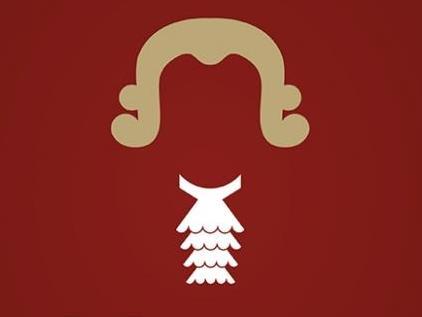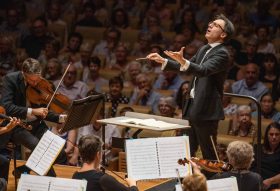Nothing could be more popular with classical music audiences than a Mozart Festival, especially one crammed with the composer’s most popular repertoire. The Melbourne Symphony Orchestra’s director of artistic planning, Ronald Vermeulen marked this occasion by inviting two HIP (historically informed performance) superstars to work with the MSO. Richard Egarr, music director of the Academy of Ancient Music, directed this second concert of four in the Festival and was joined by distinguished pianist Kristian Bezuidenhout, himself an artistic director of the Freiburger Barockorchester and principal guest conductor of The English Consort. Both are highly intelligent and imaginative musicians fully conversant with 18th-century repertoire.
It has become normal practice for a first-rate 21st-century symphony orchestra to perform in a number of different styles ranging from the Baroque through to Romanticism, Modernism and beyond, all with specific practical challenges and aesthetic qualities. Fundamental change of style within a short period, however, risks an unsettled performance. Alternating the high Romanticism of an excellent performance of Mahler’s Das Lied von der Erde a fortnight ago with this concert of translucent 18th-century Viennese Classicism promised more than it delivered. The style was vibrato-lite with brisk tempos throughout and with every aspect of its surface brimming with musical syntax. Egarr had his orchestra laid out in historically appropriate fashion with violins symmetrically placed left and right of the conductor’s podium and cellos at the centre facing the audience. But the strings conveyed only partly what Egarr was indicating particularly in his sudden shading away of phrases to emphasise the announcement of new material. There was some reoccurring imprecision in upper-string tuning, a ragged cadence at the end of the first piece and blemished ensemble entries right the way through.
Librettist Giambattista Varesco adapted for Mozart the French story of Idomeneo by Antoine Danchet. Having completed the opera, the composer set about creating ballet music before the opera’s looming opening, apparently with some difficulty, as he referred in correspondence to “those cursed dances”. The fashion in ballet spectacle was for an earlier French Baroque pomposity and grandeur, a style that Mozart disliked though was happy in this instance to emulate. The Chaconne and following Pas de Seul (de M Le Grand), K 367 – Le Grand was the ballet master – is more thematically Gluck and stylistically Rameau than authentically Mozart, with plentiful dramatic flourish and grand balletic gesture. It received a vigorous and convincing performance.
Bezuidenhout’s recordings of Mozart’s complete keyboard music with the Freiburger Barockorchester have justifiably claimed numerous important awards. His instrument of choice for this repertoire is the Viennese fortepiano, but here was performed on a modern Hamburg Steinway. An expert in the early piano, Kristian Bezuidenhout states that he would be well satisfied in playing the Mozart piano concertos for the rest of his life. He confesses to having almost lost interest in the modern piano, referring to performing Mozart on such instruments as “a kind of transcription in my mind”. This reviewer yearns for the day when Mozart’s piano concertos are performed with equally devoted musicians performing on historically correct instruments.
Bezuidenhout’s of the 23rd Piano Concerto on this occasion was effortlessly graceful and technically refined, regularly using the una chorda pedal to subtly shape sound. The Adagio in the evocative and mysterious key of F sharp minor, with its haunting Siciliano rhythm and expressive woodwind suspensions, was especially moving. The Allegro assai delighted for its natural good humour and almost child-like playfulness. However, the director surprisingly overlooked Bezuidenhout’s constant miniscule adjustment of tempo, especially in the outer movements.
Five months after the First Fleet of British ships landed in Port Jackson in 1788 to establish an English penal colony in New South Wales, Mozart’s Symphony No 40 in G minor, K 550 was premiered, though we are uncertain exactly where. It has become one of the most famous pieces of Classical music of all time. The work exists in two versions, one orchestrating a pair of clarinets written for the clarinettist brothers Anton and Johann Nepomuk Stadler being the version that we heard exuberantly performed on this occasion. The excellent clarinet solos in the Finale Allegro assai by principal clarinettist David Thomas provided a foretaste of the delights that await us this Friday night when he performs on basset clarinet Mozart’s Clarinet Concerto, composed for Anton Stadler.
Part of the Festival atmosphere, the program was embellished with letters by Mozart and others read between works by Eadric Ayres. But there were way too many of them, with some containing particularly uninteresting information (like those laboriously detailing the composer’s impecuniousness) and others only distantly relevant to the music being performed. Though well prepared by Ayres, time stood still as we waited for them all to be read before a motionless orchestra with conductor looking on.
3 ½ stars out of 5
MSO Plays Mozart 40
Richard Egarr, conductor
Kristian Bezuidenhout, piano
Presented by the Melbourne Symphony Orchestra
Hamer Hall, Arts Centre Melbourne
Saturday 15 July 2017
The MSO directed by Richard Egarr continues its Mozart Festival with a performance of the Clarinet Concerto and Requiem on Friday, 21 July in Hamer Hall, Arts Centre Melbourne at 8pm.





